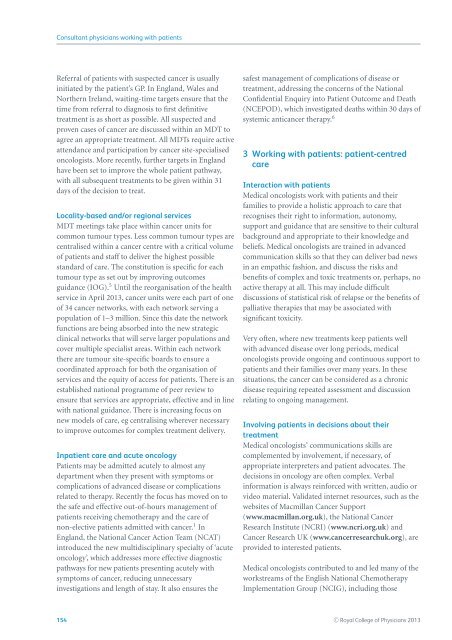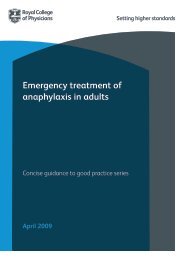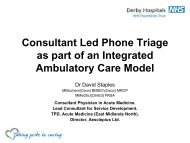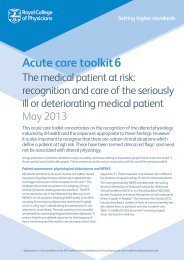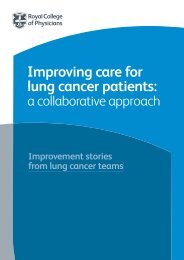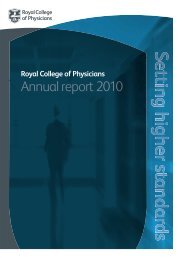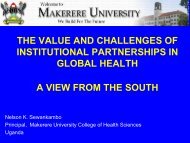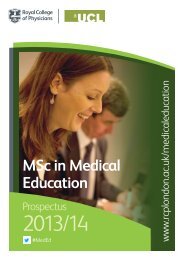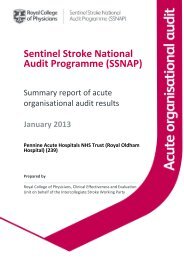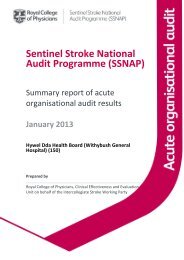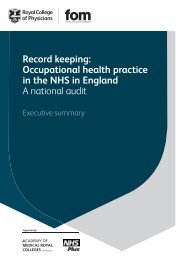Consultant physicians working with patients - Royal College of ...
Consultant physicians working with patients - Royal College of ...
Consultant physicians working with patients - Royal College of ...
Create successful ePaper yourself
Turn your PDF publications into a flip-book with our unique Google optimized e-Paper software.
<strong>Consultant</strong> <strong>physicians</strong> <strong>working</strong> <strong>with</strong> <strong>patients</strong>Referral <strong>of</strong> <strong>patients</strong> <strong>with</strong> suspected cancer is usuallyinitiated by the patient’s GP. In England, Wales andNorthern Ireland, waiting-time targets ensure that thetime from referral to diagnosis to first definitivetreatment is as short as possible. All suspected andproven cases <strong>of</strong> cancer are discussed <strong>with</strong>in an MDT toagree an appropriate treatment. All MDTs require activeattendance and participation by cancer site-specialisedoncologists. More recently, further targets in Englandhave been set to improve the whole patient pathway,<strong>with</strong> all subsequent treatments to be given <strong>with</strong>in 31days <strong>of</strong> the decision to treat.Locality-based and/or regional servicesMDT meetings take place <strong>with</strong>in cancer units forcommon tumour types. Less common tumour types arecentralised <strong>with</strong>in a cancer centre <strong>with</strong> a critical volume<strong>of</strong> <strong>patients</strong> and staff to deliver the highest possiblestandard <strong>of</strong> care. The constitution is specific for eachtumour type as set out by improving outcomesguidance (IOG). 5 Until the reorganisation <strong>of</strong> the healthservice in April 2013, cancer units were each part <strong>of</strong> one<strong>of</strong> 34 cancer networks, <strong>with</strong> each network serving apopulation <strong>of</strong> 1–3 million. Since this date the networkfunctions are being absorbed into the new strategicclinical networks that will serve larger populations andcover multiple specialist areas. Within each networkthere are tumour site-specific boards to ensure acoordinated approach for both the organisation <strong>of</strong>services and the equity <strong>of</strong> access for <strong>patients</strong>. There is anestablished national programme <strong>of</strong> peer review toensure that services are appropriate, effective and in line<strong>with</strong> national guidance. There is increasing focus onnew models <strong>of</strong> care, eg centralising wherever necessaryto improve outcomes for complex treatment delivery.Inpatient care and acute oncologyPatients may be admitted acutely to almost anydepartment when they present <strong>with</strong> symptoms orcomplications <strong>of</strong> advanced disease or complicationsrelated to therapy. Recently the focus has moved on tothe safe and effective out-<strong>of</strong>-hours management <strong>of</strong><strong>patients</strong> receiving chemotherapy and the care <strong>of</strong>non-elective <strong>patients</strong> admitted <strong>with</strong> cancer. 1 InEngland, the National Cancer Action Team (NCAT)introduced the new multidisciplinary specialty <strong>of</strong> ‘acuteoncology’, which addresses more effective diagnosticpathways for new <strong>patients</strong> presenting acutely <strong>with</strong>symptoms <strong>of</strong> cancer, reducing unnecessaryinvestigations and length <strong>of</strong> stay. It also ensures thesafest management <strong>of</strong> complications <strong>of</strong> disease ortreatment, addressing the concerns <strong>of</strong> the NationalConfidential Enquiry into Patient Outcome and Death(NCEPOD), which investigated deaths <strong>with</strong>in 30 days <strong>of</strong>systemic anticancer therapy. 63 Working <strong>with</strong> <strong>patients</strong>: patient-centredcareInteraction <strong>with</strong> <strong>patients</strong>Medical oncologists work <strong>with</strong> <strong>patients</strong> and theirfamilies to provide a holistic approach to care thatrecognises their right to information, autonomy,support and guidance that are sensitive to their culturalbackground and appropriate to their knowledge andbeliefs. Medical oncologists are trained in advancedcommunication skills so that they can deliver bad newsin an empathic fashion, and discuss the risks andbenefits <strong>of</strong> complex and toxic treatments or, perhaps, noactive therapy at all. This may include difficultdiscussions <strong>of</strong> statistical risk <strong>of</strong> relapse or the benefits <strong>of</strong>palliative therapies that may be associated <strong>with</strong>significant toxicity.Very <strong>of</strong>ten, where new treatments keep <strong>patients</strong> well<strong>with</strong> advanced disease over long periods, medicaloncologists provide ongoing and continuous support to<strong>patients</strong> and their families over many years. In thesesituations, the cancer can be considered as a chronicdisease requiring repeated assessment and discussionrelating to ongoing management.Involving <strong>patients</strong> in decisions about theirtreatmentMedical oncologists’ communications skills arecomplemented by involvement, if necessary, <strong>of</strong>appropriate interpreters and patient advocates. Thedecisions in oncology are <strong>of</strong>ten complex. Verbalinformation is always reinforced <strong>with</strong> written, audio orvideo material. Validated internet resources, such as thewebsites <strong>of</strong> Macmillan Cancer Support(www.macmillan.org.uk), the National CancerResearch Institute (NCRI) (www.ncri.org.uk)andCancer Research UK (www.cancerresearchuk.org), areprovided to interested <strong>patients</strong>.Medical oncologists contributed to and led many <strong>of</strong> theworkstreams <strong>of</strong> the English National ChemotherapyImplementation Group (NCIG), including those154 C○ <strong>Royal</strong> <strong>College</strong> <strong>of</strong> Physicians 2013


